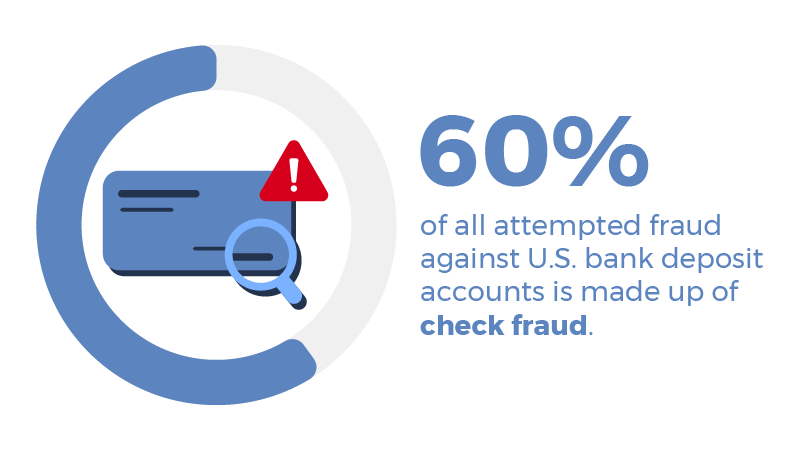Picture this: a fraudster writes a check for $5,000 from his account at a credit union and walks over to his local branch of a nationwide bank, depositing the check by scanning it in at the ATM. It’s a large check, so the bank makes half of the funds available immediately and puts the other half on hold while they wait for the check to clear. The “customer” immediately withdraws the $2,500 now available in his account – but when the bank and credit union communicate, it turns out the credit union account has insufficient funds, and the fraudster has disappeared with no intention of paying back the $2,500.
Not only is the bank now experiencing losses due to issuing a portion of the check to a bad actor, but they must also activate their fraud team to investigate the incident and hopefully collect any of the funds.
Check deposit fraud may seem like an old-school form of fraud that was more common when presentment technology wasn’t as sophisticated as it is today. However, it persists as a major challenge for financial institutions and has only been complicated by the prevalence of digital banking. In fact, the American Bankers Association reports that 60% of all attempted fraud against U.S. bank deposit accounts is made up of check fraud.1
Modern digital banking features like remote deposit capture (RDC) allow users to deposit checks by scanning them into their mobile banking app or at the ATM, and typically a portion of the funds are immediately available. However, sophisticated fraudsters are exploiting these developments to make duplicate deposits or deposit counterfeit, forged, or altered checks. It can also be easy for even well-intentioned people to deposit a check in their mobile banking app, later forget, and deposit the physical check at their local branch.
According to a 2022 Impact Report by Aite-Novarica, “first-party check and deposit fraud are on the rise. Fraudsters have been committing more sophisticated forms of fraud attacks over the past few years, but they have now turned to some low-tech fraud methods involving checks and deposits. Thirty-eight percent of fraud executives surveyed report this form of fraud is up more than 20% over the past 12 months."2
Luckily, much of this fraudulent behavior and mismanagement can be predicted and prevented using bank-contributed data and machine-learning based tools. These predictive intelligence tools analyze historical deposit and transaction data to help financial institutions (“FIs”) predict risk exposure and identify potential suspicious activity.
Here are 4 ways your FI can stop check deposit fraud with duplicate and counterfeit item detection:
1. Determine if the person is authorized to transact on the account
As digital account funding and online funds transfers become the norm, a critical step to preventing fraud is confirming that the person making an online funds transfer or funding a new account is authorized to transact on the off-us account. Using Account Owner Authentication (AOA), FIs can confirm that the person making an account transfer or funding a new account is an authorized account owner. This all occurs behind the scenes from the customer, meaning no friction is added to the process but potential fraudsters can be flagged in real-time.
2. Confirm the payer’s account exists…and if it’s in good standing
Many check fraud scams rely on depositing off-us checks, or checks originating from a different bank than the one where it is being deposited.
When a customer deposits a check originating from a different bank, it generally takes around two days to clear, and it can take up to a week for funds to be received from the originating FI. However, many banks and credit unions make some portion of the funds available immediately, allowing the scammer to withdraw cash before the bank discovers the account on the other end is closed or has non-sufficient funds.
Confirming that the payer’s account exists and is in good standing prior to allowing the funds to be deposited is crucial for minimizing losses from returns.
3. Flag potential duplicate items in real-time
With the introduction of digital options like ATM deposits and RDC, fraudsters can attempt to negotiate one check multiple times, and even well-meaning customers can occasionally make mistakes.
In some cases, scammers will attempt to deposit the same check into multiple accounts at different banks using RDC. In other cases, fraudsters will deposit a check using mobile and later attempt to cash the physical check in-person.
Many duplicate deposits can be avoided by adding duplicate item detection to a point of presentment screening to detect checks that have already been presented at another FI or via mobile or ATM deposit.
4. Predict the likelihood that a check will be returned
Although many checks are not fraudulent, you can protect your bank from taking losses on those that are fraudulent. Checks that are fraudulent may be associated with a pattern of returns and historical negative account statuses Putting a predictive solution in place provides insights into the account management behaviors an FI can use and helps them to make informed decisions about which deposits to accept from their customers.
How can you implement these strategies to prevent fraud at your financial institution?
Fraud tactics are constantly evolving, but some of the traditional methods like check fraud continue to pose significant challenges to financial institutions of all sizes. Getting ahead of fraud helps FIs operate more efficiently by empowering them to spend the time and resources they would have spent investigating fraud on more important things, like opening more new accounts or improving the customer experience. Putting solutions in place that can help predict fraudulent behavior before it can occur has become more critical than ever.
Early Warning’s real-time Predictive Intelligence solutions, like Deposit Chek® , provide banks and credit unions with the predictive intelligence they need to get ahead of fraud. By screening off-us or on-us checks and ACH against our National Shared DatabaseSM , Deposit Chek® Service confirms the status of an account and predicts the likelihood that a check will be paid while validating that the external account is owned by the customer requesting the funding transaction. It runs in the background, enabling FIs to monitor and detect fraud while still providing a seamless customer experience.



